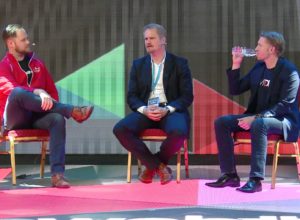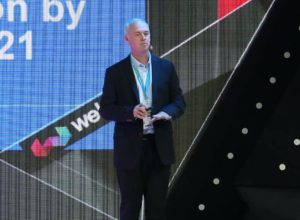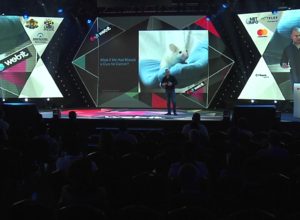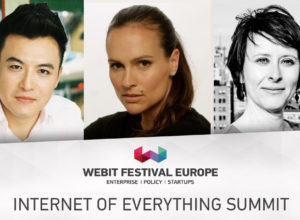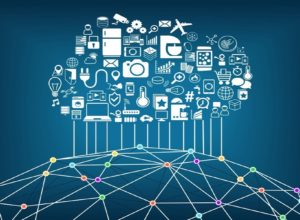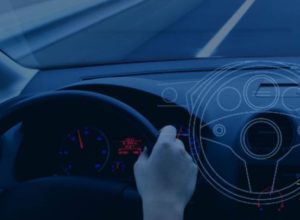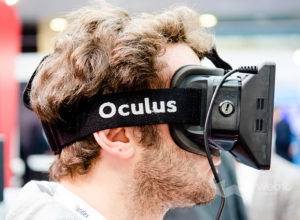Tag: IoT
Dancing with an Elephant: Corporates & Startups
Apply for our Founders Games and get the chance of being among the 200 startups presenting their innovative idea in front of investors, business leaders and all attendees of Webit.Festival 2018.
Corporates & startups. Two forces of the business world which are as much different as they need each other. Brian Collins (AngelHack), Jonas Jacobi (IBM) & Matthias Schanze (Siemens) put some light on this complex relationship Mr. Schanze described as”Dancing with an elephant”
The open API (Application Programming Interfaces) revolution took of 5 years ago
A familiar example of APIs in action is the ability to sign into different accounts or services with our Facebook login. We can log into Pinterest, for example, by using our Facebook login credentials. That revolution was built on the idea that corporates could start opening up their technology for developers & startups. By doing so they were able to find a whole new strategy. In that way, the strategy shifted. It shifted from a B2B or a B2C focus to a Business to Developer focus. As such, innovation programming quickly went on the rise. Corporates began looking at developers and startups as a whole new strategy to their strategic plans and in doing so they’ve started working and finding ways to engage with startups & developers at an earlier and earlier stage.Why the relationship between startups & corporates is important
Big companies have more than enough funds to put in place and do their own research. What these companies have noted is that a lot of innovation occurs outside the company itself. That’s one of the main reasons companies like IBM, Siemens and others of this size have been involved in the startup ecosystem for quite some time already. Startups do set trends and it’s important for large corporations to always keep an eye on new trends and new technologies that are emerging fast. So what are these companies looking for? Big ideas. Great technologies. And innovations. Innovations that disrupt industries and possibly create new markets. Transformation, not only for the company itself but for its clients as well.Value proposition to the corporates
Corporates are well aware that they cannot invent everything by themselves. Co-creation and co-innovation with startups is a key point of their development. The transition is turning from internal Research & Development departments inside of corporates towards creating an external community, a liquid R&D force in essence. There’s the notion that most big corporates engage with, acquire or invest their funds in startups that already make some millions of revenue but in reality that is not the case anymore. The practice of an early engagement has grown immensely and that calls for more fair chances for more startups.Privacy, Security and Internet of This, That & Tomorrow
Travis LeBlanc, former Chief of Enforcement Bureau at the Federal Communications Commission
Free Internet access - a thing available at the click of a mouse or a tap on a screen for most people. But in the not so far future this wasn’t the case. An open and free Internet access still isn’t the case in a number of countries around the world. Though the UN has proclaimed Internet access as a human right.Privacy, Security and Internet of This, That & TomorrowNowadays almost all newly launched companies rely heavily on the Internet ecosystem
This trend carries numerous possibilities with it, combined with numerous unknowns too. The number of connected devices is constantly increasing. This includes not only our smartphones but any IoT devices ranging from connected vehicles through surveillance systems to our hairbrush. The IoT boom certainly provides benefits - creating smart devices, managing energy efficiency, forecasting needed repairs or whatever need it is. But at the same time carrying a number of threats with it. There have been cases as hackers obtaining personal data from institutions, taking control on connected cars and even being able to reach to a person’s pacemaker. All this serves as an example reminding us how insecure the devices we so heavily rely on are. Three years ago, the Federal Communications Commission has issued regulations to prevent broadband Internet service providers from controlling the access that consumers have to the Internet, from choosing which websites and apps we can use - basically, from choosing the winners and losers on the Internet. It has also taken measures in order to protect broadband privacy, to ensure that consumers know what particular information about them is collected from these providers, what do they do with it and to prohibit them from selling the consumers’ information without their consent.Recently though, these regulations have been reversed
Service providers are able to sell consumers’ information such as browsing history, apps downloaded, location, etc. to the highest bidder, be it the government, marketers or certain bad actors. That is enough scary of a concept by itself, having in mind how much information is contained in the smart devices we use daily. Governments and regulators should proceed from the point that everything can be hacked. At some point, it’s very likely to happen and prompt measures need to be taken to prevent or at least minimize the harm. This concerns all companies creating products and services for the market. Security and privacy issues need to be considered from the start of developing a certain product. They should not be left for figuring out after the process has finished and the damage has already been done. If you want to stay tuned with evolving security & privacy matters, the Webit.Festival 2018 in Sofia gathers some of the world’s pioneers on the subject.M&A as a Fuel to Innovation
Sriram Prakash, the Global Lead for Innovation M&A and Venturing Services at Deloitte was one of the speakers at Webit.Festival Investments Summit who shared his insight about fueling growth through innovation M&A.
Living in an economy of expectations
An innovation can come from anywhere.It can come from a small unknown town in India, it can come from a booming city like New York, it can come from anywhere. If you want to turn your innovation into a billion dollar business though, you need some extra things than the idea itself. You need an ecosystem, you need entrepreneurs and corporates, you need the governments and different policy makers. And in fact, there are very few cities and ecosystems allowing you to do that but this doesn’t mean that your ideas can’t travel. Ideas have no boundaries anymore and that’s become quite an advantage for all market players. Markets are full of uncertainty today, they are getting saturated and there’s a backlash against globalization. For the past three years revenue growth rates has been on the decline but the share price are on the rise. That’s why innovation has become such a strong priority for companies to grow. Mergers & acquisitions is one of the ways for companies to tap into innovations happening outside of their private ecosystem rather than trying to focus on purely growing organically.More and more non-technological companies are investing in and acquiring tech companies
This means that a nowadays startup has the option of not just one but more exits and more than one sectors that could be interested in its particular innovation. The process is not one-way only. It’s not only old companies trying to go into digital. Startup companies are also buying some old style companies depending on their needs. Most of the disruptors under the scope of corporates are AI, Robotics, Big Data, Analytics and IoT, finally coming to a stage where the commercial potential can be realised. Venture capital & investment companies trying to get their way through the field should be better in the way of trying to find what people want rather than trying to invent the next Facebook or Uber. The biggest battle is for the future of consumers and the consumer industry as changing as it is. Companies of different sectors are merging and acquiring others out of their area of business and specialization. We see healthcare industry mixing with Fintech, IoT with Data and all together. For the first time there’s a genuine convergence between non-traditional sectors converging around a particular opportunity.There will be 48 billion IoT devices by 2021 and 30%...
Bluetooth technology is developing with steady pace to satisfy customers, said industry veteran Martin Wooley from Webit.Festival Europe 2017 stage. He is Technical Program Manager EMEA for Bluetooth Segway - the standard body behind Bluetooth technology and told us how the company is regularly improving the range and the transfer speed of its devices.
"Back in the 1990’s there were a billion devices connected to the internet. But only 10 years later their number doubled to 2 billion largely thanks to the smartphones. The forecast for 2021 though is staggering. 48 billion devices will be connected to the Internet and 30% of them will be Bluetooth devices. This is not coincidence - Bluetooth has been systematically developed over the years to keep pace with the market requirements and and to enable new things. And it has become a key enable of the Internet of Things (IoT)", Mr Wooley said, when talking about the future of the IoT industry.
He explained how Bluetooth is now heavily used in the medical and fitness industries rather than just being replacement for cable.
"In the beginning Bluetooth was a cable-replacement technology that gave us wireless mice and keyboards and some great audio solutions. Wind the clock forward to 2020 and Bluetooth Low Energy is in pretty much every smartphone and tablet on the planet. It also gave rise to medical devices, health and fitness devices, wearable technology and so on. More recently Bluetooth 5 was released. The headline changes we have made were that we’ve made it twice as fast, we increased the range by a factor of 4 and the capacity of broadcasting data was increased by a factor of 8", the expert said.
He also explained more about the bluetooth beacons used more and more by huge businesses.
"You can use Bluetooth devices in two ways. They can either connect to each other and exchange data over the connection or they can work in a connection-less way, with one device just broadcasting data that any other device can see. Beacons are prime use case for the application of this broadcasting capabilities and the numbers are really interesting. Over the last couple of years we have shifted from companies that are running small pilot projects to rolling out serious deployments of beacons into their businesses and the forecasts are amazing. By 2021 the estimates are that there will be more than 500 million beacons shipped in that one year alone", Mr Wooley expects.
IoT is the key to solving the complex world of science
We often think about innovation and science as a one whole thing. But in the age of connectivity and information sharing most of the science-based organizations remain disconnected from the Cloud computing and its amazing capabilities.
Fortunately this is going to change fast because of the fast development of IoT solutions that are going to cut the research and development costs of companies and help them invest more into amazing science discoveries that will benefit all of us.
During the IoE Summit of Webit.Festival Europe the Founder and CEO of Elemental Machines Sridhar Iyengar took us on a journey through the process of making science in the Digital Age and shared his vision about overcoming the obstacles that science-based companies face today.
Sridhar also founded AgaMatrix, a blood glucose monitoring company that made the world’s first medical device connecting directly to the iPhone and shipped 15+ FDA-cleared medical products, 2B+ biosensors, 6M+ glucose meters, with partnerships with Apple, Sanofi, and Walgreens. He is a holder of over 30 US and international patents.
His presentation showed our guests how the IoT technologies are accelerating science-based work and are helping for the development of new drugs and products that are crucial for our common future.
Iyengar explained that for investing in science-based organizations is often perceived as too risky for venture capitalists and angel investors. The main reason is that such activity requires serious initial capital and is still full of unknowns.
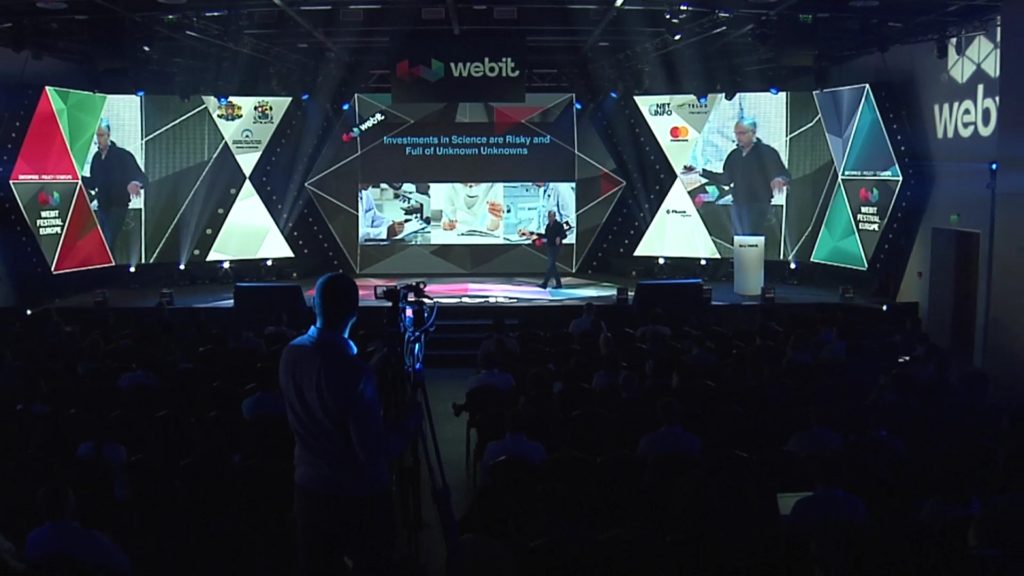 The Founder & CEO of Elemental Machines Sridhar Iyengar[/caption]
Right now pharmaceutical companies invest millions of dollars in research and development, but very little of this scientific world is actually connected to the Cloud. We already have smart homes and devices, and now is the time to develop smart laboratories and factories that are able to share their results and reap the power of cloud computing.
Maybe the best example of that is the San Francisco company Emerald Cloud Lab (ECL), which Iyengar described as “the Amazon for science”. It has developed a fully robotized laboratory. If you have a science experiment you just have to go to their website and code the process and machines will execute it.
The first cloud connected laboratory in the entire world gets the human error out of the equation and guarantees the same results in every execution of the process. In the long-term offering experimentation as service may revolutionize the science-based businesses by cutting their costs and removing the need to develop their own research in development facilities.
Another example of great innovation is the Bay Area company VIUM, which have a digital mouse lab and removes the actual mice from the drug test process. It collect terabytes of data on mice with dozens of sensors.
The Founder & CEO of Elemental Machines Sridhar Iyengar[/caption]
Right now pharmaceutical companies invest millions of dollars in research and development, but very little of this scientific world is actually connected to the Cloud. We already have smart homes and devices, and now is the time to develop smart laboratories and factories that are able to share their results and reap the power of cloud computing.
Maybe the best example of that is the San Francisco company Emerald Cloud Lab (ECL), which Iyengar described as “the Amazon for science”. It has developed a fully robotized laboratory. If you have a science experiment you just have to go to their website and code the process and machines will execute it.
The first cloud connected laboratory in the entire world gets the human error out of the equation and guarantees the same results in every execution of the process. In the long-term offering experimentation as service may revolutionize the science-based businesses by cutting their costs and removing the need to develop their own research in development facilities.
Another example of great innovation is the Bay Area company VIUM, which have a digital mouse lab and removes the actual mice from the drug test process. It collect terabytes of data on mice with dozens of sensors.
“I’m from Boston and biotech companies here raise $40 million as their first round of investment. And most companies don’t raise that much money through the entire process of their existence. Yet if you are going to develop a drug it is going to cost you tens, or even hundreds of millions of dollars”, the expert explained.People who work in technology fields understand Moore’s Law and the fact that the processing power of computers is growing exponentially. But what most of us don’t realize is that in biotech world it is quite the opposite. Eroom’s Law (Moore’s Law spelled backwards) says that as the years goes on the amount of money needed to produce new a single drug is growing. So for every $1 billion dollars that is invested into making a new drug, you get less and less ROI. One of the main obstacles before making science is the fact that every activity is done in the physical world. This creates hundreds of factors that influence and cause variations in the end result. According to Iyengar doing science is very similar to writing code. Working in a laboratory or a manufacturing facility requires following a procedure and a protocol. Code is nothing more than a set of procedures and steps that machine executes. When things co wrong in code, developers have tools, called debuggers. But in science there are no such tools and the debugging process is much harder.
“It is pretty much like baking a cake. You follow recipe, you bake it and supposedly you should get the cake out. If each of us took home the same recipe for chocolate cake and we came back tomorrow, we will probably have dozens of slightly different kinds of cakes, even that we followed the same procedure. In cooking it is okay, but when you are making a drug, it is no”, he said.In software our operating system may be iOS, Windows, Linux or else. But in science-based industry the operating system is the physical world. Because every time doing experiment, every time you test something on a mouse, every time you do a sequence of a genome, the physical world changes. And if you are trying to do the same things in two different days, you have to make sure that all the conditions are the same. This is the most important thing about science - that everything is based on physical properties. When something goes wrong with your final product there are millions things that could have caused why it could went wrong. And finding that is actually really hard and takes a lot of time and resources. [caption id="attachment_5044" align="aligncenter" width="640"]
 The Founder & CEO of Elemental Machines Sridhar Iyengar[/caption]
Right now pharmaceutical companies invest millions of dollars in research and development, but very little of this scientific world is actually connected to the Cloud. We already have smart homes and devices, and now is the time to develop smart laboratories and factories that are able to share their results and reap the power of cloud computing.
Maybe the best example of that is the San Francisco company Emerald Cloud Lab (ECL), which Iyengar described as “the Amazon for science”. It has developed a fully robotized laboratory. If you have a science experiment you just have to go to their website and code the process and machines will execute it.
The first cloud connected laboratory in the entire world gets the human error out of the equation and guarantees the same results in every execution of the process. In the long-term offering experimentation as service may revolutionize the science-based businesses by cutting their costs and removing the need to develop their own research in development facilities.
Another example of great innovation is the Bay Area company VIUM, which have a digital mouse lab and removes the actual mice from the drug test process. It collect terabytes of data on mice with dozens of sensors.
The Founder & CEO of Elemental Machines Sridhar Iyengar[/caption]
Right now pharmaceutical companies invest millions of dollars in research and development, but very little of this scientific world is actually connected to the Cloud. We already have smart homes and devices, and now is the time to develop smart laboratories and factories that are able to share their results and reap the power of cloud computing.
Maybe the best example of that is the San Francisco company Emerald Cloud Lab (ECL), which Iyengar described as “the Amazon for science”. It has developed a fully robotized laboratory. If you have a science experiment you just have to go to their website and code the process and machines will execute it.
The first cloud connected laboratory in the entire world gets the human error out of the equation and guarantees the same results in every execution of the process. In the long-term offering experimentation as service may revolutionize the science-based businesses by cutting their costs and removing the need to develop their own research in development facilities.
Another example of great innovation is the Bay Area company VIUM, which have a digital mouse lab and removes the actual mice from the drug test process. It collect terabytes of data on mice with dozens of sensors.
“They know how much they sleep, how much they walk around, which direction is their nose pointed, how often they feed. And every single thing is captured, so that when something goes wrong you have a huge database where you can go through and debug what may have happened”, Iyengar said.Тhese are two examples of how IoT, connected devices and cloud computing are being applied to drug discovery and science and research, but there are many more to come. You may watch Sridhar Iyengar’s full lecture here: If you want to keep up with the latest trend in the world of digital economy and technology, then Webit.Festival is the right place for you. Visit our website and book 2 of our Super Earlybird tickets for Webit.Festival Europe 2018 for just €100. Feel the Webit vibe with some of the best photos from this year’s event! [easingslider id="4954"]
Take a look at the impact of IoE on our lives...
Tech experts around the world list the Internet of Everything (IoE) as one of the top trends in the digital economy. The term brings together people, processes, data and things to make networked connections more relevant and valuable than ever before and create new opportunities for businesses, individuals and countries.
Expansion of this process is connecting people in more relevant and valuable ways. It helps for converting data into intelligence and making better decisions. IoE delivers the right information to the right person at the right time, while connecting physical devices and objects to the internet.
Many new technologies will enable a wider range of IoE services and some of them will also pose interesting challenges for implementation.
The upcoming 5G tech is intended to enable network operators to evolve their current business models to support a wider variety of relationships with partners and customers in the IoE.
Meanwhile network functions virtualization and cloud technologies have the potential to radically change communications and office environments from physical world to reality where everything is software-based and easy to change.
At this year’s Webit.Festival you can listen to some of the top experts in this innovative field of digital industry. During the IoE Summit they will share their thoughts on the development of IoT, Smart Homes, M2M, Wearables, Education Tech and Virtual and Augmented Reality.
The CEO of Amyx+ Scott Amyx will show how to successfully execute in IoT and how to turn disruption into innovation. The expert is winner of the Cloud & DevOps World Innovation award and was voted among the top IoT Influencers & Experts by Inc. Magazine.
Right after him, the CEO of Elemental Machines Sridhar Iyengar will show us how IoT is helping solve the complex world of science and will explain why smart devices are still not a part of every research laboratory.
The Global Editorial Director of Wall Street Journal Custom Studios Fara Warner will speak on the best ways to tell a story in the world of virtual and augmented reality from media’s point of view.
Josh Software’s Co-founder Gautam Rege will share his thoughts on the future of smart homes, where everything happens at the touch of a button and how it will affect our quality of life.
The CEO of TechHuddle Richard Yeo will talk about the current state of ecommerce and will give his predictions for the future of IoE.
Meanwhile, the Vice President of SCA for Digital Transformation Gael De Talhouet will tell the audience about the rise of IoT and subscription models and the automation of purchases.
Here you can see a full list of the confirmed speakers at Webit.Festival, while here you can get all the information you need about the tickets for the event.
IoE makes us dream of a more connected tomorrow
We are living in the time of the Fourth Industrial Revolution - a process that unites biological, digital and physical spheres. And perhaps the most important condition for unfolding of this process is the coming age of Internet of Everything (IoE).
According to most experts, it will bring an enormous shift on our way of living, solving problems and creating value for business. In the near future our cars, houses, fridges, stoves, light bulbs, clothes and visual devices will all be interconnected.
This has the potential to create new capabilities, richer experiences and unprecedented economic opportunity for businesses, countries and individuals.
A Business Insider analysis calculates that by 2020 there will be around 34 billion devices connected to internet worldwide, compared to 10 billion in 2015. Internet of Things (IoT) devices will account for 24 billion, while traditional computing devices as smartphones and tablets will be around 10 billion.
Over the next five years the market for IoT solutions will reach nearly $6 trillion. Business is looking like the top customer of this kind of products because of the perspective for lowering of operation costs, increased productivity and expanding to new markets.
By year 2020 more than 5 billion people will be connected to the web. This is nearly seven times more than their number in 2000. The new internet users will come mainly from Africa and Asia and their connection will be mobile. This creates entirely new economic reality, which is already happening.
Just yesterday the idea of smart homes was interesting mostly for geeks and wealthy executives from the tech industry. But platforms like Amazon’s Alexa are soon going to make this concept affordable for nearly everyone in the developed world.
With the coming of more people online, companies like Google are trying to make their services more accessible with smaller apps for budget devices and offline support.
Today the tech giant announced that its Google search app for Android will save our queries while we are offline and deliver the results when our internet connection is established again.
As Android is the most used operating system in developing economies where the internet quality is low this new feature will be pretty helpful for the millions of new users. Soon the company is going to apply it for iOS too.
Meanwhile, Google is working with LG on producing the first Android Wear 2.0 devices - the LG Watch Sport and LG Watch Style. The smartwatches will be revealed on February 9. Both devices have options for Wi-Fi and Bluetooth connectivity, while the sport model features cellular connectivity with 3G and LTE data, as well as GPS.
As for now the expansion of wearables benefits mostly retailers and technological businesses, but the new features in these devices have the potential to improve our day-to-day activities and quality of life.
IoE will make us more self aware in every life aspect of life, from eating habits and sport to management of our home and finances.
You can learn more about the rise of mobile tech, sharing of information and connected devices during Webit.Festival 2017. During the two-day agenda of the festival in Sofia you can listen to top level speakers from all over the world, who will share their experience on topics, such as Marketing & Innovation, Big Data & Cloud, IoE, Digital Transformation, FinTech & Blockchain, Security & Privacy, Health & Wellbeing and Mobility.
How Internet of Things Revolutionizes Customer Services
The Internet of Things (IoT) is everywhere around us. At home, in the phone, smart watch, in the glasses and clothes we wear, in the car we drive, in the shop we visit at the enterprise.
Businesses realize that they can get a lot more by delving deeper and using the great opportunities provided by the IoT and the connected world.
What about using IoT for communicating with the customer online and in real time and making him a happy and loyal client. What about using IoT for one to one customer engagement and improvement.
How the Internet of Things is Revolutionizing Customer Services is the topic that Vishal Dhar, co-founder of iYogi a Digital Service Cloud will be presenting at the blue track of the Global Webit Congress.
Yogi’s Digital Service Cloud is a platform for supporting the Internet of Things (IoT) world, endorsed by 2.5+ million users across 10 countries. It currently provides support for over 500 technologies in the Digital Home. Vishal’s current role is forging new partnerships with IoT solution providers across multiple industry verticals to increase adoption for emerging technologies.
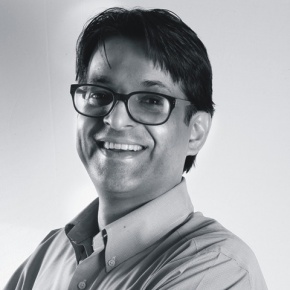 One of the things Vishal learnt during his days in the creative scene in New York, as he dabbled in entertainment, publishing and the arts, was the importance of doing something new all the time.
After setting up a gallery of contemporary art, he decided to venture into Public Relations, Content Marketing and creating Rich Databases for business media companies. And the journey just went on. He founded three companies before iYogi happened.
At iYogi he runs a tight, and fun, ship marketing its services across multiple geographies. On Fortune magazine’s list of Asia’s 25 hottest people in business last year, Vishal always has something to do or somewhere to go. Quite like iYogi itself, actually.
One of the things Vishal learnt during his days in the creative scene in New York, as he dabbled in entertainment, publishing and the arts, was the importance of doing something new all the time.
After setting up a gallery of contemporary art, he decided to venture into Public Relations, Content Marketing and creating Rich Databases for business media companies. And the journey just went on. He founded three companies before iYogi happened.
At iYogi he runs a tight, and fun, ship marketing its services across multiple geographies. On Fortune magazine’s list of Asia’s 25 hottest people in business last year, Vishal always has something to do or somewhere to go. Quite like iYogi itself, actually.
 One of the things Vishal learnt during his days in the creative scene in New York, as he dabbled in entertainment, publishing and the arts, was the importance of doing something new all the time.
After setting up a gallery of contemporary art, he decided to venture into Public Relations, Content Marketing and creating Rich Databases for business media companies. And the journey just went on. He founded three companies before iYogi happened.
At iYogi he runs a tight, and fun, ship marketing its services across multiple geographies. On Fortune magazine’s list of Asia’s 25 hottest people in business last year, Vishal always has something to do or somewhere to go. Quite like iYogi itself, actually.
One of the things Vishal learnt during his days in the creative scene in New York, as he dabbled in entertainment, publishing and the arts, was the importance of doing something new all the time.
After setting up a gallery of contemporary art, he decided to venture into Public Relations, Content Marketing and creating Rich Databases for business media companies. And the journey just went on. He founded three companies before iYogi happened.
At iYogi he runs a tight, and fun, ship marketing its services across multiple geographies. On Fortune magazine’s list of Asia’s 25 hottest people in business last year, Vishal always has something to do or somewhere to go. Quite like iYogi itself, actually.
“The customer service industry is about to see an IoT tsunami change in the next five years. Just as consumers will experience a whole host of new applications; brands, service providers and OEMs will realize the full opportunity of IoT enabled customer services and support." says Vishal DharWhant to hear more and participate in the discussion? Join Vishal Dhar at the blue track of the Global Webit Congress and learn about the hot topic of IoT and how it revolutionizes customer services. Book your tickets now!
Can Wearable Devices change our life?
Wearable devices are all around and wearable technology is changing our life styles by allowing us to track and interact with the surrounding world in new ways. They are changing the perception of the ways we see, hear and interact with the world around us.
According to ABI Research, about 90 million wearable devices will be sold in 2014 and demand will be higher in 2015. Most wearables are related to health and fitness but the future will see them in other fields.
What are wearable devices?
According to Wikipedia “wearable technology“, “wearable devices“, and “wearables” all refer to electronic technologies or computers that are incorporated into items of clothing and accessories which can comfortably be worn on the body.
Wearable devices, similar to mobile phones and laptop computers can perform the same computing tasks in some cases outperforming them. They have embedded sensors and can transmit information. Wearable technology tends to be more sophisticated than mobile devices providing sensory and scanning features not typically seen in mobile and laptop devices, such as biofeedback and tracking of physiological functions.
Why do we use them?
They are all around us watches, glasses, contact lenses, e-textiles and smart fabrics, headbands, jewelry such as rings, bracelets, and earrings. Most wearables on the market today are fitness and healthcare monitors.
Worn on our head like the Google Glass and Oculus Rift, on our wrist like the Pebble steel, Fitbit Flex or Nike + Fuelband, Moto 360, on our chest like the Uber Armour Chest strap or Polar Wearlink and Transmitter, on our ankle like the Adidas F50 Aadizero TRX Cleats. They are being intercorporated in our clothes. They can be attached to a baby like the Sproutling Baby monitor that senses, learns and predicts a baby's sleep habits.
What are the future trends for wearable devices?
Wearables still are a technology for early adopters. They are not perfect and there are still lots of questions to be resolved. Privacy, safety, design and customer adoption, just to mention a few. However, the future of wearable devices looks promising. Juniper research predicted the market to jump from its current $2 billion value to $19 billion by 2018.
An in the world of IoT giants like Google, Microsoft, Apple, Intel, IBM are working on new and improved solutions to help wearables. Apple is set to release its new and exciting iWatch expected to be a game changer. Intel is working on standards of interoperability. We are seeing better integration and new applications developed for the wearable devices. The startup community is also working on new devices and solutions.
Join us at the blue track of the Global Webit Congress to learn more on these promising new technologies.
Get your early bird ticket now.
